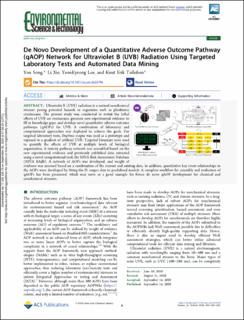| dc.contributor.author | Song, You | |
| dc.contributor.author | Xie, Li | |
| dc.contributor.author | Lee, YeonKyeong | |
| dc.contributor.author | Tollefsen, Knut-Erik | |
| dc.date.accessioned | 2020-11-13T10:00:21Z | |
| dc.date.available | 2020-11-13T10:00:21Z | |
| dc.date.created | 2020-09-28T12:04:25Z | |
| dc.date.issued | 2020 | |
| dc.identifier.issn | 0013-936X | |
| dc.identifier.uri | https://hdl.handle.net/11250/2687740 | |
| dc.description.abstract | Ultraviolet B (UVB) radiation is a natural non-chemical stressor posing potential hazards to organisms such as planktonic crustaceans. The present study was conducted to revisit the lethal effects of UVB on crustaceans, generate new experimental evidence to fill in knowledge gaps, and develop novel quantitative Adverse Outcome Pathways (qAOPs) for UVB. A combination of laboratory and computational approaches were deployed to achieve the goals. For targeted laboratory tests, Daphnia magna was used as a prototype and exposed to a gradient of artificial UVB. Targeted bioassays were used to quantify the effects of UVB at multiple levels of biological organization. A toxicity pathway network was assembled based on the new experimental evidence and previously published data extracted using a novel computational tool, the NIVA Risk Assessment Database (NIVA RAdb). A network of AOPs was developed and weight of evidence assessed based on a combination of the current and existing data. In addition, quantitative key event relationships in the AOPs were developed by fitting the D. magna data to predefined models. A complete workflow for assembly and evaluation of qAOPs has been presented, which may serve as a good example for future de novo qAOP development for chemical and non-chemical stressors. | en_US |
| dc.language.iso | eng | en_US |
| dc.rights | Attribution-NonCommercial-NoDerivatives 4.0 Internasjonal | * |
| dc.rights.uri | http://creativecommons.org/licenses/by-nc-nd/4.0/deed.no | * |
| dc.subject | Biostatistikk | en_US |
| dc.subject | Biostatistics | en_US |
| dc.subject | Fysiologi | en_US |
| dc.subject | Physiology | en_US |
| dc.subject | Biokjemi | en_US |
| dc.subject | Biochemistry | en_US |
| dc.subject | Systembiologi | en_US |
| dc.subject | Systems biology | en_US |
| dc.title | De novo Development of a Quantitative Adverse Outcome Pathway (qAOP) Network for Ultraviolet B (UVB) Radiation Using Targeted Laboratory Tests and Automated Data Mining | en_US |
| dc.type | Peer reviewed | en_US |
| dc.type | Journal article | en_US |
| dc.description.version | publishedVersion | en_US |
| dc.subject.nsi | VDP::Økotoksikologi: 489 | en_US |
| dc.subject.nsi | VDP::Eco-toxicology: 489 | en_US |
| dc.source.journal | Environmental Science and Technology | en_US |
| dc.identifier.doi | 10.1021/acs.est.0c03794 | |
| dc.identifier.cristin | 1834150 | |
| dc.relation.project | Norges forskningsråd: 223268 | en_US |
| dc.relation.project | Norges forskningsråd: 268294 | en_US |
| dc.relation.project | Norges forskningsråd: 301397 | en_US |
| dc.relation.project | Norsk institutt for vannforskning: NIVA Computational Toxicology Program (NCTP) | en_US |
| cristin.ispublished | false | |
| cristin.fulltext | original | |
| cristin.qualitycode | 2 | |

